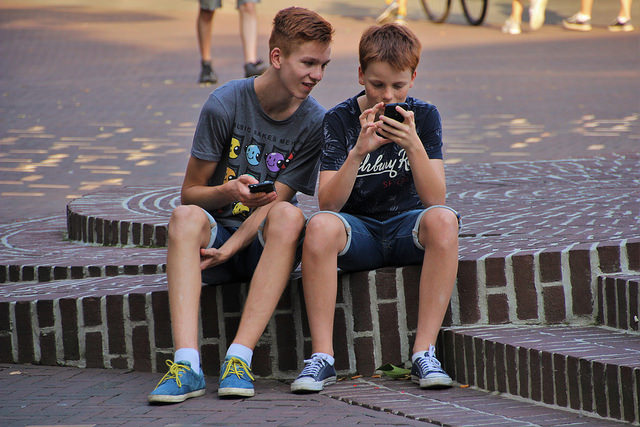We live in a world of constant noise, constant distraction, constant busyness.
And, for young people, this chaotic, noisy world is the only one they know.
It’s their reality—so much so that, for many of them, the experience of silence or space is eerily uncomfortable.
As soon as this generation of children were capable of holding an iPad or their mom or dad’s iPhone, these devices were placed in their hands to keep them entertained. Their world is 24/7 distraction.
I’ve been a teacher for over 20 years. One thing I know for sure is that kids struggle with focus more today than ever before. Yet, in this over-tested culture, we are asking them to focus for longer periods of time.
Even at school, bells ring, teens scream, announcements interrupt, cellphones beep, and an undercurrent of chatter vibrates throughout the building. Gone are the days of a quiet school hallway and obedient children listening intently to their teachers. After school, many of my students go home to chaotic households with multiple siblings and stressed-out parents yelling. Most of these kids have never experienced the peaceful sounds of nature or the serenity of solitude. To escape chaos, they put in their earbuds and tune out to pop, hip hop, or gaming music.
It was several years ago when I first noticed my high school students becoming increasingly distracted, irritated, stressed, and abnormally anxious. I didn’t know what to attribute it to, but I knew I needed to do something. At the same time, I was in the middle of a divorce and feeling distracted and anxious myself. It’s amazing how the universe gives you exactly what you’re looking for when you need it.
An email popped up in my inbox announcing a “Mindfulness Workshop for Educators” at a local university. At the time, I had no idea what mindfulness was, but it sounded intriguing and like a possible tool for my anxiety-ridden teens. Little did I know that attending that workshop would change the trajectory of my teaching style, and my life.
Meanwhile, at home, I couldn’t function. My mind swirled, my heart raced, and an overwhelming feeling of dread consumed my body. I wasn’t sleeping or eating. I was forgetting conversations and events that happened the day before. I left a trail of half-started chores, bills went unpaid, and I wasn’t present with my own children. They would speak to me, but I would look right through them, never hearing what they said. Like an 80-year-old suffering with dementia, I would repeat questions. They’d respond, annoyed, “Mom, I just told you!”
I knew I was losing it—certifiably losing it. I don’t know if I had a nervous breakdown or if I was on the verge of one. I reluctantly made a doctor’s appointment. I’d always been the strong one, the mentally healthy one, the together one. Now, I hesitantly divulged my personal life to my family doctor of 30 years. Shame and embarrassment flooded my face and shook my voice, but she handed me what I thought I needed: a prescription for Xanax.
Xanax is a sedative used to treat anxiety and panic disorders. The doctor warned me that the medication is highly addictive. I started out on a low-dose which “took the edge off” and got me through the day. However, if I took too much, I’d become tired and sluggish, and it would feel as though the world were moving in slow motion.
Finally, the day of the mindfulness conference came—a crisp, autumn day full of promise.
The professor took out a Tibetan singing bowl and gently tapped it. As the soothing tone vibrated to its end, we closed our eyes and sat in silence, listening to the subtle noises in the room. I took deep breaths and, for the first time in months, felt peace. The quiet stillness of the room and the inhalation of life-giving oxygen cleared my mind, and I knew I’d be okay. I’d discovered my new Xanax, repackaged as meditation.
I immediately began a personal daily practice. I diligently worked to stay present with people and be in the moment with whatever task I was doing. It wasn’t easy. As they say, old habits die hard. What kept me practicing mindfulness was the sense of peace, calmness, and clarity I experienced. Beyond that, creative and unique ideas popped into my head out of nowhere. I’d wonder, surprised, “Did I really think of that?” In my heart, I know those ideas were divinely gifted to me. The key to receiving was stilling my mind.
Since the conference, I have completed four more mindfulness courses specific to educators, and I have recently been accepted into a year-long trainer program. My goal, one day, is to begin a mindfulness program district wide.
Today, my students meditate with me daily. At first, they complained that sitting in silence was weird and uncomfortable. But soon, they came to appreciate the silence. Many said it was the first time they had heard it. I thought that was so profound. These kids had grown up in a world without silence.
For my students, mindfulness includes meditation to increase focus; learning to respond versus react to challenging situations, awareness and acceptance of emotions, and emotional equanimity. I have witnessed increased respect between students in my classroom, fewer behavioral issues, increased focus, and improved communication skills since incorporating mindfulness and meditation into the curriculum. And, when students ask me if I can teach mindfulness to their parents, I know I’m positively affecting this unique generation.
On days when we don’t have time to meditate, my students will ask adamantly, “What about mindfulness? We want to do mindfulness.” It is in those moments that I know, without a doubt, mindfulness has reshaped their lives as much as it has mine.
I wholeheartedly believe mindfulness is a game-changer in education.
We teach our children reading, writing, and arithmetic, but we fail in one key area. We fail to teach them the skills needed to cope with and break out of dysfunctional generational patterns, addictions, poor communication, trauma, tragedy, and every other obstacle in this messy human experience we call life.
It is easy to begin a mindfulness practice; the challenge is to stick with it. Here are some pointers that might help.
Begin a practice by letting go of judgement.
There is no right or wrong way to meditate. To meditate is to learn about the busyness of the mind, the topics that may be consuming us, and the origin of the emotions that can rock us. Even more importantly, it is to observe the present moment without judgement. In other words, no matter what thoughts cross my mind, I will not judge them as good or bad. They are only thoughts.
Start with short increments of time.
Each fall, my new students begin meditating for one minute and build up from there. I instruct them to focus on their breath. If their mind wanders, they bring it back to a deep breath. Throughout the semester, I build up their stamina and explore various types of meditation, from guided meditation to experiencing the changing sensation of the taste and texture of a raisin in their mouth.
It is so rewarding to see the “aha” moment when they realize they are not the voice in their heads. When they understand the value of the present moment, I feel like I have taught them the foundation of not only mindfulness, but of life. Once they have this knowledge, it is a simple reminder to stay present that allows them to release the pain of the past and the uncertainty of the future.
Be consistent.
Consistency is the key to a successful meditation practice. Like exercising or eating nutritious food, meditating regularly contributes to a healthy lifestyle—even if it is only a few minutes a day. The best part of mindfulness and meditation is that it doesn’t cost anything and can be practiced anywhere.
Finally, be kind to your wandering mind.
When it wanders, bring it back to the present moment. Even if it is only for several minutes a day, taking time to meditate or be in the present moment with a person or task contributes to a balanced mental state.
I sincerely believe that a good education leads to success in life, but only if we incorporate tools to help our children cope with real life challenges.
Teaching children mindfulness and meditation at an early age has the potential to positively transform this generation, future generations, and eventually the entire human race.
Maybe I am excessively optimistic, but I am also practical. I know our children need coping skills as much as they need academics.
Let’s try something new and teach our children the benefits of meditation and mindfulness, at home and in school. In an increasingly chaotic world, it certainly can’t hurt.
~
Relephant reads:
Meditation is not about being Perfect, it’s about This.
The Simple Technique that Changed My Life.
Building a Peaceful Generation: Why Meditation Should be Taught in Schools.
~
Author: Jill Carbone
Image: Skinny Casual Lover/Flickr
Editor: Khara-Jade Warren
Copy Editor: Travis May
Social Editor: Yoli Ramazzina


 Share on bsky
Share on bsky





Read 4 comments and reply